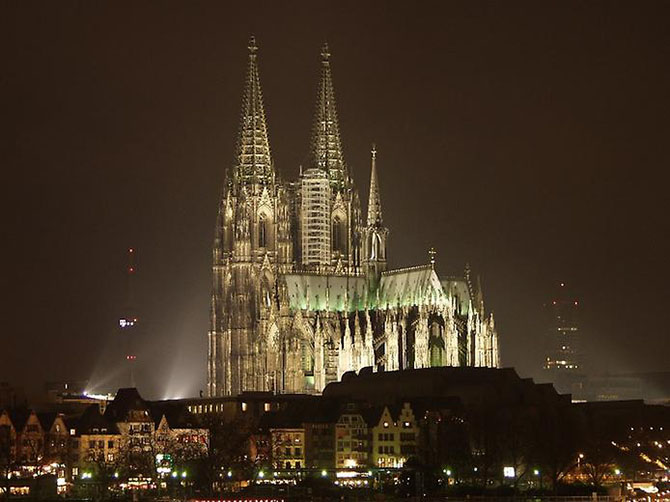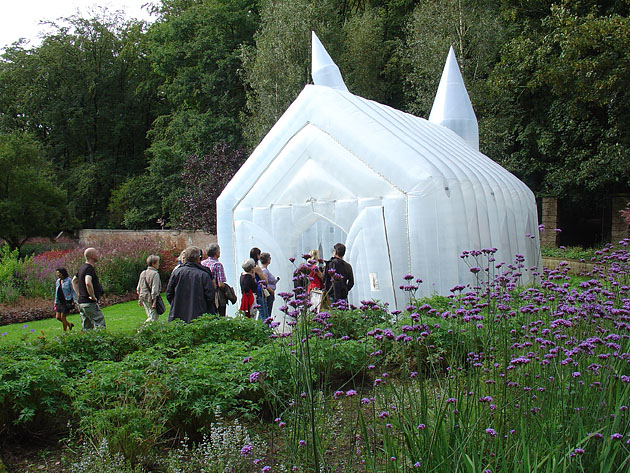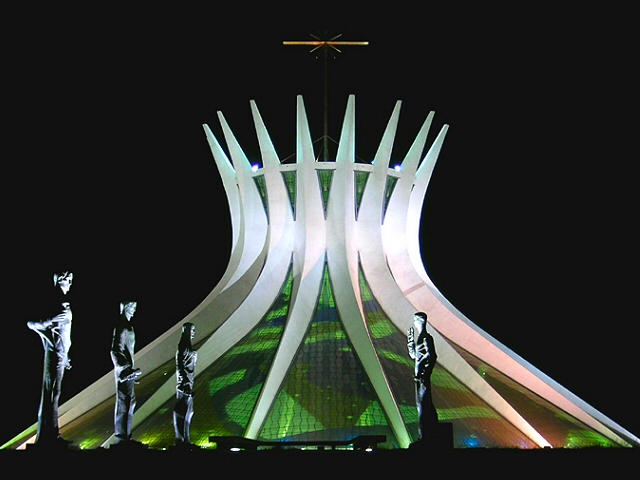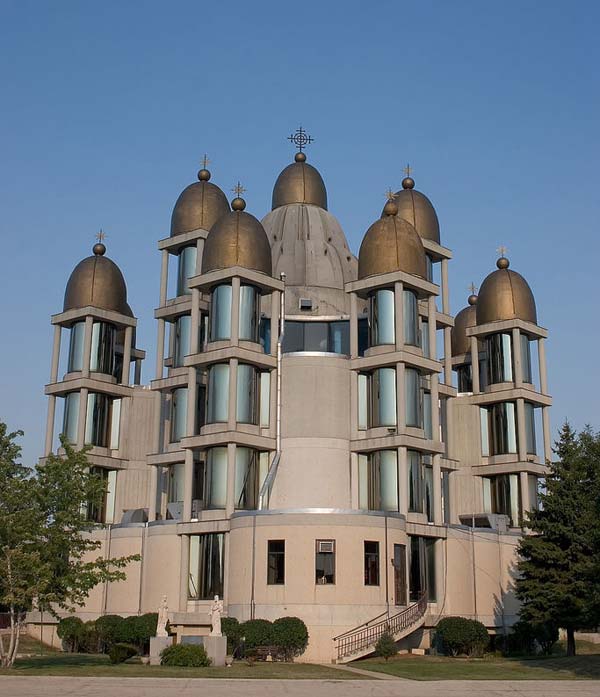Most churches can be identified at first glance as places of religious worship. However, there are some churches that surprise and even shock believers with their appearance.
1. Chapel of the Holy Cross

This remarkable church building is built into the picturesque red rocks above the city of Sedona and is one of the man-made wonders of the American state of Arizona. The chapel, designed by architect Richard Hein, was built in the 1950s with funds from devout Catholic Marguerite Staude. The design of the building was inspired by the Empire State Building.
According to local believers, the chapel is located in a special, energetically powerful place. They believe that in the area of the building, the boundaries between worlds are very thin, and this contributes to spiritual healing. Others say that the chapel is simply a beautiful place for reflection.
2. Ossuary in Sedlec

This Gothic church in the Kutna Hora area of the Czech Republic offers a new perspective on the use of human remains. The interior of the ossuary, as its name suggests, is decorated with human bones and skulls. Legend has it that Abbot Henry returned from the Holy Land in the 13th century and brought soil from Calvary with him. He scattered it around the cemetery. Many people who heard about this asked to be buried on holy ground, but there was not enough space for everyone in the cemetery. In the early 15th century, a cathedral with a crypt was built on the cemetery grounds. And the bones removed from the graves (to make room for new burials) began to be stored in the crypt. Over time, their number grew and grew. It was not until the 19th century that woodcarver František Rint began to bring order to the pile of disorderly skeletal parts.
This is what it led to:
— In each corner of the church he placed a bell-shaped pile of bones 3 meters high and 4 meters wide.
— A huge chandelier made of bones and skulls hangs from the ceiling to the floor.
— Cups and urns made from bones filled the niches on the walls.
— Perhaps the most impressive creation of Master Rint is the coat of arms of the noble Czech family of Schwarzenberg, made of bones. It contains an image of a raven pecking out the eye of a decapitated head.
3. Basilica of Saint Ursula

In this basilica you can see the largest mosaic made from parts of human bodies.
According to legend, Saint Ursula was a British princess who lived around 300-600 AD. Being a deeply religious girl, Ursula decided to go on a pilgrimage around Europe. Along with her, 11 thousand virgins went on the trip (according to other versions - only 11, or there were 11 ships, not girls - it is no longer clear after so many years). Their ships miraculously got from Great Britain to Rome, and then, due to strong winds, headed for Cologne. At this time, the Huns were ravaging Europe. Ursula was captured by them and tortured, along with her companions.
Subsequently, the relics of Saint Ursula were placed in a basilica built in Cologne. But in the Middle Ages, a pit full of bones was discovered. It was decided that these were the remains of Ursula's retinue and they were also transferred to the basilica. Now they adorn the walls of the Golden Chamber.
Interestingly, many of the "virgin" bones actually belonged to men, infants, and even large dogs.
4. Cathedral in Maringa

While the Chapel of the Holy Cross blends in with its surroundings, the Cathedral in the Brazilian state of Parana stands in stark contrast to the local landscape. This huge conical structure is not only one of the strangest cathedrals in the world, but also the tallest Catholic church in South America, at 124 meters. The purpose of the unusual design of the city temple was to bring people closer to God. Well, falling from its top will certainly direct anyone to meet the Almighty by the shortest route.
Interesting fact: the shape of the cathedral was “suggested” to its architects by Soviet satellites. The author of the initial project was Don Jaime Luis Coelho, and the authorship of the final architectural version belongs to Jose Augusto Bellucci.
5. Reading between the lines

This strange name is shared by an equally strange church in Borgloon, Belgium. To address the dichotomy between the abundance of churches and their seemingly increasing irrelevance in the modern world, architects Peterjan Gijs and Arnout Van Vaerenbergh built the unique Reading Between the Lines Church. It is made of one hundred layers of steel and allows people to see the landscape on the other side of the church. The cavities between the steel plates give the building a surprising lightness, and if you go inside, you can enjoy the bizarre play of light and shadow.
This structure is not used for regular church services and is essentially a work of art. However, any believer has the right to freely enter the "transparent" church and pray.
6. Chen Chappell

In second place in the ranking of amazing churches is an ancient French church built inside a giant 800-year-old oak tree. According to local legend, William the Conqueror himself prayed under this tree.
In the 17th century, the tree was used as a chapel after lightning struck it and burned the wood inside. This event left the oak tree hollow but still alive. Taking the lightning strike as a sign from God, the local abbot converted the tree's shell into a chapel.
In the 18th century, atheist revolutionaries threatened to burn the tree, but local residents saved it, renaming it the "temple of reason" to match the "attitudes" of the Great French Revolution.
7. Katskhi Pillar in Georgia

This is probably the most unusual church on Earth, and one of the places closest to the "heavenly office." After all, the church is built on a large limestone monolith, the height of which is 40 meters.
At one time, pagans used this monolith to worship the god of fertility, but this ceased when Georgia converted to Christianity.
Around the seventh century, a small church was built on top of the pillar. It was a visible embodiment of withdrawal from the vanity of life and closeness to God. Monks used it for religious ceremonies until Georgia was invaded by Ottoman Turkey.
In the 18th century, attempts were made to climb the Katskhi pillar, but all of them ended in failure, and it was conquered by Soviet researchers only in 1944.
A study of the upper part of the column showed that there were once cells, a crypt, and a wine cellar, meaning that monastic life was not deprived of all earthly pleasures.
In 1993, a lonely monk, Father Maxim, moved into a grotto under a stone column and lived there all winter. He collected donations for the construction of the temple, and achieved his goal - construction began in 2008, and was carried out with the support of the townspeople and the clergy.
Currently, in the southeast of the Katskhi pillar there is a temple named after Maximus the Confessor. Local residents have given the building another name – “The Fortress of Solitude”.
8. Arctic Cathedral

Lutheran Church in the Norwegian city of Tromsø. According to the architect's idea, the building, consisting of two merging triangular structures covered with aluminum plates, should evoke an association with an iceberg.
9. Cologne Cathedral

The Roman Catholic Gothic Cathedral in Cologne, Germany, is the third tallest church in the world and is a World Heritage Site. The main church of the Cologne Archdiocese was built in two stages: from 1248 to 1437 and from 1842 to 1880. Upon completion, the 157-meter cathedral became the tallest building in the world for four years.
10. Mosque in Tirana

A project for a cultural centre in the Albanian capital Tirana, which will include a mosque, an Islamic cultural centre and the Museum of Religious Harmony. The international competition for the project was won last year by the Danish architectural firm BIG.
11. Sheikh Zayed Mosque

The snow-white marble Sheikh Zayed Grand Mosque, one of the six largest mosques in the world, is located in Abu Dhabi. It was opened in 2007, and since March 2008, tours of the mosque have been available to everyone, not just Muslims. The mosque has the world's largest carpet and the largest chandelier.
12. Milan Cathedral

The world-famous fourth largest church in the world is located in the very center of Milan and is its symbol. This late Gothic wonder contains a forest of spires and sculptures, marble pinnacles and columns. The white marble cathedral was built over 5 centuries.
13. St. Michael's Golden-Domed Monastery

One of the oldest monasteries in Kyiv. Includes the newly built St. Michael's Golden-Domed Cathedral, a refectory with the Church of St. John the Evangelist and a bell tower. It is assumed that St. Michael's Cathedral was the first temple with a gilded top, from where this unique tradition began in Rus'.
14. Inflatable Church

Dutch philosopher Frank Los came up with the idea for the inflatable Transparent Church, which can be erected anywhere in the world and under any conditions: at festivals, private parties and other public events. The inflatable church fits easily into the trunk of a car and when disassembled can accommodate about 30 parishioners.
15. Notre-Dame-du-Haut

A concrete pilgrimage church built in 1950-55 in the French town of Ronchamp. Architect Le Corbusier, not being religious, agreed to undertake the project on the condition that the Catholic Church would grant him complete freedom of creative expression. Initially, the unconventional building caused violent protests from local residents, who refused to supply the temple with water and electricity, but by now tourists coming to see it have become one of the main sources of income for the residents of Ronchamp.
16. Transfiguration Church on Kizhi Island

The Church of the Transfiguration of Our Lord on Kizhi Island in Karelia is a nanotechnology of wooden architecture, the apogee of carpentry. The church was founded in 1714 and is part of the architectural ensemble of the Kizhi Pogost, included in the UNESCO World Heritage List. The basis of the composition of the structure is an octagonal log house - "octagon" - with four two-stage extensions located on the cardinal points. Two more octagonal log houses of smaller sizes are successively placed on the lower octagon. The church log house is chopped in the traditions of Russian carpentry - without nails. There are nails only in the domes.
17. Painted church in Arbor

The painted churches are the most famous architectural landmarks of Moldova. The churches are decorated with frescoes both outside and inside. Each of these churches is listed as a UNESCO World Heritage Site.
18. Cathedral of Our Lady in Tears

The cathedral in the form of a concrete tent rises above the Italian city of Syracuse. In the middle of the last century, an elderly couple lived on the site of the cathedral, who had a statue of the Madonna. One day, the statue began to "cry" with human tears, and pilgrims from all over the world flocked to the city. A huge cathedral was built in her honor, perfectly visible from any point in the city.
19. St. Basil's Cathedral

The Orthodox church is located on Red Square in Moscow. It is a widely known monument of Russian architecture and one of the most famous landmarks in Russia. It was built in 1555–1561 by order of Ivan the Terrible to commemorate the victory over the Kazan Khanate. According to legend, the architects of the cathedral were blinded by order of Ivan the Terrible so that they could not build another such church.
20. Las Lajas Cathedral

One of the most visited temples in Colombia. The construction of the temple was completed in 1948. The neo-Gothic cathedral is built directly on a 30-meter arched bridge connecting the two sides of a deep gorge. The care of the temple is carried out by two Franciscan communities, one Colombian, the other Ecuadorian. Thus, the Las Lajas Cathedral became a pledge of peace and union between the two South American nations.
21. Cathedral of the Blessed Virgin Mary

The Cathedral of the Catholic Archdiocese of Brasilia was built in the modernist style according to the design of the famous architect Oscar Niemeyer. In 1988, Oscar Niemeyer received the Pritzker Prize for the unique design of the Cathedral. The building consists of 16 hyperboloid columns, symbolizing hands raised to the sky. The space between the columns is closed with stained glass.
22. Salt Cathedral of Zipaquirá

The Zipaquira Cathedral in Colombia is carved out of solid salt rock. A dark tunnel leads to the altar. The cathedral is 23 m high and can accommodate over 10,000 people. Historically, there was a mine in this area used by the Indians to extract salt. When the need for this disappeared, a temple appeared on the site of the mine.
23. Stave Church in Borgund

One of the oldest surviving frame churches is located in Norway. Metal parts were not used in the construction of the Borgund Stave Church. And the number of parts that make up the church exceeds 2 thousand. The sturdy frame of the pillars was assembled on the ground and then raised to a vertical position using long poles. The Borgund Stave Church was built presumably in 1150-80.
24. Hallgrimskirkja

The Lutheran Church in Reykjavik is the fourth tallest building in Iceland. The church was designed in 1937 by architect Gudjón Samuelsson. It took 38 years to build the church. The church is located in the center of Reykjavik and is visible from any part of the city. It has become one of the main attractions of the city and is also used as an observation tower.
25. Kailash Temple

The Hindu Temple of Kailash, carved entirely out of rock, is located in the Indian state of Maharashtra. The architectural feats of the Indian builders involved in the creation of the Kailash Temple are stunning. The work began in the 8th century and lasted for more than 100 years. As a result, the structure occupies an area twice as large as the Parthenon in Athens in Greece. It is one of the largest temples in the world, rivaling even the Taj Mahal in Agra. It rises more than 30 meters and almost its entire surface is covered with intricate carvings.
26. Lotus Temple

The Lotus Temple is located near New Delhi, India. Construction was carried out from 1978 to 1986, largely funded by imprisoned Iranian Baha'is. The architect was Canadian Fariborz Sahba.
27. Church of St. George

A cave church, entirely carved out of the rocks, is located in the Ethiopian city of Lalibela. The building is a cross 25 by 25 meters and goes underground for the same amount. This miracle was created in the 13th century by order of King Lalibela, according to legend, in 24 years. In total, Lalibela has 11 churches, completely carved out of the rocks and connected by tunnels.
28. Grundtvig's Church

Lutheran church located in Copenhagen, Denmark. It is one of the most famous churches in the city and a rare example of a religious building built in the expressionist style. The competition for the design of the future church was won in 1913 by architect Peder Klint. Construction lasted from 1921 to 1926.
29. Paraportiani Church

The dazzling white church is located on the Greek island of Mykonos. The temple was built in the 15th-17th centuries and consists of five separate churches: four churches are built on the ground, and the fifth is based on these four.
30. Church of St. Joseph

The Ukrainian Greek Catholic Church of St. Joseph in Chicago was built in 1956. It is known worldwide for its 13 golden domes, symbolizing the 12 apostles and Jesus Christ.
31. Church of the Holy Family

The church in Barcelona, built with private donations since 1882, is the famous project of Antonio Gaudi. The unusual appearance of the temple made it one of the main attractions of Barcelona. However, due to the complexity of the stone structures, the cathedral will not be completed before 2026.
32. Church of Consolation

Situated in the Spanish city of Cordoba, the still very young church was designed by the architectural bureau Vicens + Ramos last year according to all the rules of strict minimalist canons. The only deviation from the strict white color is the golden wall in place of the altar.
33. United States Air Force Academy Cadet Chapel

It is located in the state of Colorado on the territory of a military town and training base of the branch of the US Air Force Pilot Academy. The monumental profile of the chapel building is created by seventeen rows of steel frames ending in peaks at a height of about fifty meters. The building is divided into three levels, and services of the Catholic, Protestant and Jewish confessions are held in its halls.
34. Chapel of the Crown of Thorns

The wooden chapel is located in Eureka Springs, Arkansas, USA. The chapel was built in 1980 by architect E. Fay Jones. The light and airy chapel has a total of 425 windows.
35. Farmers' Chapel

The concrete chapel on the edge of a field near the German town of Mechernich was built by local farmers in honour of their patron saint, Bruder Klaus.
36. Chesme Church

Or the Church of the Nativity of St. John the Baptist is an active Orthodox church in St. Petersburg, located on Lensoveta Street, an architectural monument in the pseudo-Gothic style. The church building was built to commemorate the victory of the Russian fleet over the Turkish in the Chesme Bay of the Aegean Sea in 1770
37. Jubilee Church

Or the Church of the Merciful God the Father is a community center in Rome. It was built by the architect Richard Meier between 1996 and 2003 with the aim of revitalizing the life of the residents of the area. The temple is built of precast concrete on a triangular site on the edge of a city park, surrounded by 10-story residential and public buildings with a population of about 30,000 residents.












